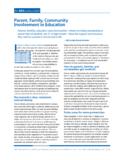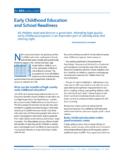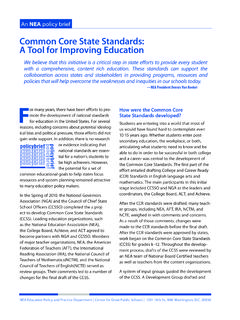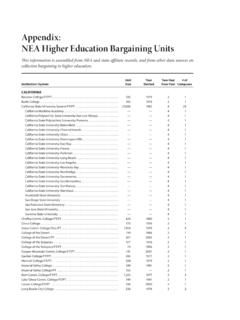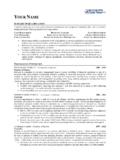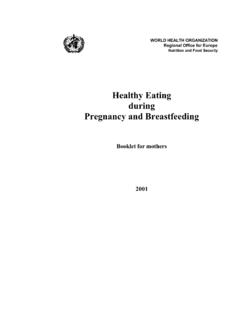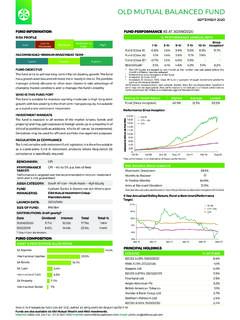Transcription of Preventing Future High School Dropouts - NEA
1 Preventing FutureHigh School Dropouts An Advocacy and Action Guide for NEA State and Local AffiliatesPreventing FutureHigh School Dropouts An Advocacy and Action Guide for NEA State and Local Affiliates By Marcella R. Dianda, and Civil Rights1201 16th St., , DC 20036-3290 National Education AssociationOfficersDennis Van RoekelPresidentLily EskelsenVice PresidentRebecca (Becky) PringleSecretary-TreasurerExecutive DirectorJohn I. WilsonNEA Human and Civil RightsSheila Simmons, National Education Association is the nation s largest professional employee organization, representing million elementary and secondary teachers, higher education faculty, education support professionals, School administrators, retired teachers, and students preparing to become November 2008 Copyright 2008 by the National Education AssociationAll Rights ReservedMessage from the NEA President.
2 IiiAbout the Author .. ivExecutive Summary ..1 Introduction: Why Affiliates Should Read This Guide ..19 Chapter 1: What NEA Has To Say About dropout Prevention ..21 Chapter 2: Why high School Dropouts Are Everyone s Concern ..27 Chapter 3: Unraveling Graduation and dropout Statistics .. 33 Chapter 4: Locating the dropout Crisis in Your State and Community .. 51 Chapter 5: Advocating for Students Who Are at high Risk of Dropping Out .. 61 Chapter 6: Identifying Interventions That Have a Track Record of Success .. 77 Chapter 7: Implementing School Practices and Policies to Increase Graduation 89 Endnotes ..109 References .. 125 ContentsLet us be absolutely clear about the dropout problem. Year in and year out, it takes a terrible toll on our young people, es-pecially in poor and minority communities.
3 For America, the costs of doing nothing about Dropouts are enormous and far outweigh the costs of , the dropout problem will not be solved in a month or a year. It has been with us for as long as there have been schools. At education conferences in the second half of the 19th century and early 20th century, how to keep students in School often topped the agendas. Back then, getting just half the general student population to graduate high School was considered a worthwhile but lofty goal. Today, of course, such a graduation rate, even for a single group of students or district, is , and most importantly, measures can be taken to prevent students from dropping out. Yes, the problem is chronic and deep-rooted, and yes, it has bedeviled us for years, but that is no excuse for inaction. The dropout problem is not intractable.
4 Again, let us be absolutely clear. There are solutions, and educators are a part of those solu-tions, but we are not the solution. This has to be a collaborative effort. This is why NEA has joined with organizations such as America s Promise Alliance and Jobs for America s Grad-uates to prevent students from dropping know some of NEA s local and state affiliates are already engaged in serious dropout pre-vention work. I hope this advocacy and action guide enriches your ongoing efforts. What s more, I hope the guide will encourage those of you who have not yet engaged in this im-portant work to begin. The guide presents concrete practices and policies that will enable you to make a differ-ence. And please note that many of the same measures we have been advocating to close the achievement gaps also help solve the dropout problem: preschool that is free and avail-able to all; full-year public kindergarten; smaller class sizes, especially in the early grades; timely and targeted interventions for students with attendance, behavioral, or academic problems; and improved professional development for educators.
5 Likewise, as educators, we know we have to do a better job in the curriculum and in our classrooms of engaging minority students, be they American Indians or Native Hawaiians, Blacks or Latinos. The renowned African American author, Ralph Ellison, had some excel-Message from the NEA Presidentlent advice for us: If you can show me how I can cling to that which is real to me, while teaching me a way into the larger society, then I will not only drop my defenses and my hostility, but I will sing your praises and help you to make the desert bear fruit. I am under no illusions, however, that dropout prevention will be easy. If it were, the drop-out problem would have been solved by now, and we could focus our energies has been 10 years since the Department of Education published a dropout report en-titled No More Excuses.
6 In the preface to that report, the authors wrote this: What troubles us and adds to our collective impatience in submitting this report is precisely that so much of this has appeared so often in the research Yet the nation has failed to put this knowledge to That is sobering. But NEA is determined to put its knowledge to work to solve the dropout problem, as part of our commitment to transform public education by 2020. We and our partners see this as a marathon, not a sprint, and we plan to cross the finish line Van RoekelNEA PresidentAbout the AuthorMarcella Dianda is a Senior Policy Analyst in the NEA Human and Civil Rights Department. In education for 30 years, she worked in educational research and development prior to joining the NEA. While at NEA she has written numerous policy papers for NEA and other audiences.
7 In her present position, she focuses on closing student achievement gaps and high School dropout prevention. Her doctorate is from UCLA. Preventing Future high School Dropouts An Advocacy and Action Guide for NEA State and Local AffiliatesviExecutive SummaryNEA state and local affiliates have an important role to play in Preventing students from dropping out of high School . Although the issue is complex, it is possible to prevent Future Dropouts , and this Guide can help affiliates meet this important goal. Why Affiliates Should Read This GuideEach chapter of the Guide is written for NEA state and local affiliates. Recognizing that leaders and staff are busy, the Guide: 1. Identifies areas and School districts with the highest dropout rates and discusses what affiliates can do about it; 2. Supports affiliates advocacy efforts in addressing out-of- School factors that increase dropout rates; 3.
8 Shares School practices and policies that increase high School graduation rates; 4. Identifies effective dropout prevention programs; 5. Documents the negative effects Dropouts have on the nation s economy; 6. Demystifies graduation and dropout statistics. Chapter 1: What NEA Has To Say About dropout PreventionOver the past few years, NEA has released its dropout prevention and intervention plan; published criteria that characterize a great public School ; and proposed a new balance in the federal, state, and local education partnership to make every public School great by 2020. Dropouts Can Be Prevented through Focused Action. In its dropout prevention and intervention plan, NEA advances strategies from preschool through age 21: 1. Intervene prior to kindergarten; 2. Involve families in students learning; 3.
9 Provide students with individual attention; 4. Monitor students to track their academic progress; 5. Involve the community in dropout prevention; 6. Provide educators with the training and resources they need to prevent students from dropping out; 7. Implement career and workforce readiness programs in schools; 8. Provide graduation options for students; 9. Raise the compulsory School attendance age; 10. Open graduation centers for students who are 19 21 years of age; 11. Gather and report accurate dropout rates; 12. Increase federal funding to support dropout prevention. Preventing Future high School Dropouts An Advocacy and Action Guide for NEA State and Local Affiliates2 These 12 action steps are supported by NEA s vision of great public schools. These are schools with quality programs and services that meet the full range of children s needs; high expectations and standards; a rigorous and comprehensive curriculum; and a qualified, caring, diverse, and stable workforce.
10 A New Federal Role Would Address Factors Contributing to Dropping Out. NEA proposes a new balance in the federal, state, and local education partnership to make every public School great by 2020. The new balance requires federal leaders to more fully support states and districts and to assist them in addressing some of the key factors that contribute to high dropout rates. NEA recommends that the federal government:1. Require states to develop Adequacy and Equity plans describing how they will remedy disparities in educational tools, services, opportunities, and resources among districts and schools as part of their applications for funds under the Elementary and Secondary Education Act (ESEA). 2. Guarantee full funding for Title I and the Individuals with Disabilities Act (IDEA). Pair full funding with additional federal resources to meet the needs of special populations of students ( , English Language Learners, low-income students).
